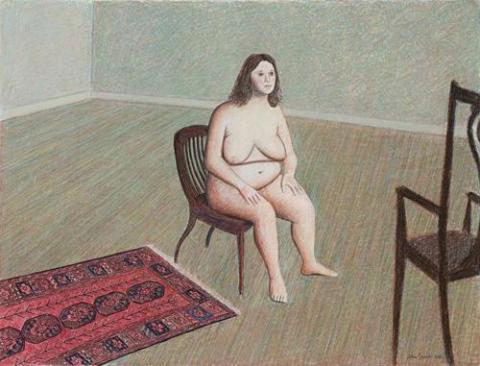NUDE ON A SMALL CHAIR, 1975
John Brack
pastel on paper
66.5 x 86.5 cm
signed and dated lower right: John Brack 1975
label attached verso inscribed with artist's name and title
Joseph Brown Collection, Melbourne
Private collection, Melbourne
Autumn Exhibition, Joseph Brown Gallery, Melbourne, March 1976 (illus. exhibition catalogue pl. 66)
John Brack, Drawings 1945–1979, Monash University Gallery, Melbourne, 1981 (illus. exhibition catalogue pl. 51)
John Brack: A Retrospective Exhibition, National Gallery of Victoria, Melbourne, 10 December 1987 – 31 January 1988
Lindsay, R., John Brack, National Gallery of Victoria, Melbourne, 1987, p. 143, cat. 181, p. 109 (illus.)
Thomas, D., Outlines of Australia's Art: The Joseph Brown Collection, 3rd Edition, MacMillan, Melbourne, 1989, p. 313 (illus.)
Grishin, S., The Art of John Brack, Oxford University Press, Melbourne, 1990, vol.II, p. 65, cat. p219, p. 226 (illus.)
'When I paint a woman.. I am not interested in how she looks sitting in the studio, but in how she looks at all times, in all lights, what she looked like before and what she is going to look like, what she thinks, hopes, believes and dreams. The way the light falls and casts its shadows is merely boring and a hindrance unless it helps me to show these things.'1
Discussing Brack's portrayal of the nude in works such as the present, Sasha Grishin notes
'The conceptual elements remain relatively constant. The nude, who in her pose frequently echoes an artistic convention, generally refers to the past and to tradition; the bare studio with its naked walls and plain receding floorboards, refers to reality and the present situation; while the oriental carpet - the carpet paradigm - as if separating two worlds nevertheless forms a strange physical bridge between the them'
The notion that the nude is vulnerable and that the old classical stability is now permanently lost to a new reality characterised by uncertainty is a common feature 'Tilted planes, diving oblique compositional lines, and sharp unexpected angles all contribute to a generally disquieting atmosphere. Brack stands back from his subject with godlike detachment; there is an evasiveness and withdrawal which in itself seems to imbue the subject with ambiguity. Brack is impersonal, not only in his technique but also in his artistic invention, in the way Piero della Francesca and Vermeer can be described as impersonal. This detachment and the self-contained hermetic circle of artistic concerns make his nudes relatively immune to psychoanalytical interpretations such as have plagued many great masters of the nude, including Degas.'2
1. Brack on Brack, CAE Discussion Group Art Notes, 1957, p. 3
2. Grishin, S., The Art of John Brack, Oxford University Press, Melbourne, 1990, vol.I, pp. 117-121.
